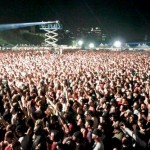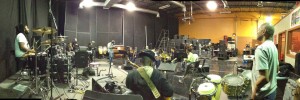[From Greg: Here’s another guest blogger. I met Liza Kravinsky maybe a year ago, when she hired me as a consultant, to help her work out a strategy for launching the project she describes here. The things we talked about don’t enter into her post; maybe they’ll come up in later posts she might make, or maybe they won’t. That doesn’t matter, because what I loved was the project itself. And especially the way that it didn’t simply combine pop and classical music — that’s been done quite a lot — but also brought together pop and classical musicians. And in a long-term collaboration, not just as a one-shot, like Grizzly Bear playing with the Brooklyn Philharmonic, or Elvis Costello creating The Juliet Letters with the Brodsky Quartet.
[More: these are street-level pop musicians, not pop stars famous for all kinds of chops. Still more: the style of pop music involved in Liza’s piece is something with fierce local roots in the place where the project is happening.
[All these things are rare, if not unique. And they give the project a kind of street energy not always found in pop/classical collaborations. So — even though I’d talked about Liza and her work in one of my mavericks posts — I thought I’d invite her to guest-blog the ongoing growth of her project. Which, not at all incidentally, I liked quite a bit as music.
That’s enough from me! On to Liza.]
After a decades long detour into pop and commercial music, I have recently returned to the classical music world where I began as a composer. I was surprised to learn what had become of the classical music world during my absence. Orchestras going bankrupt? Shrinking audiences? Wow! On top of that, I hear talk of incorporating more popular forms of music to revive the scene. Maybe my detour wasn’t such a detour after all. From my point of view, I think there is more hope than you may realize.
I saw that for myself at a recent pops concert in Washington DC. The fans were ready to dance and clap even before the orchestra started playing. Then the music began — first with a melody; and then with the beat the crowd had been aching for. They cheered.
even before the orchestra started playing. Then the music began — first with a melody; and then with the beat the crowd had been aching for. They cheered.
“I can’t believe the orchestra is playing go-go! I can’t believe the orchestra is playing go-go!” a woman beside me kept repeating in awe. She was verbalizing the thoughts and feelings I sensed in the audience.
She and I were part of thousands who gathered on September 4, 2011 to hear the National Symphony Orchestra play with Chuck Brown, who invented go-go music. Go-go music is a sub genre of funk that has been extremely popular in the Washington, DC area since the 1970’s, especially with African Americans. Its main feature is live funky polyrhythm — endless amounts of it — with drums, congas, cowbells, timbales, rototoms, and tambourines. It also uses improvisation and audience call and response. The beat never stops during a show; one song just morphs into the next.
So far, go-go itself has not become famous outside of DC; but its fans have been loyal for decades. When Brown passed away last spring, thousands came to his funeral service to say goodbye. His beat lives on through other go-go bands and in music around the world. You are probably familiar with this hypnotic swinging beat; it’s all over today’s hiphop, R&B, and alternative rock music. It is the foundation for human beatboxing.
Go-go fans were always proud when Chuck received honors like a Grammy nomination, and now a symphony orchestra pops concert. In their minds, this event is huge like that.
Even Chuck Brown couldn’t believe “the orchestra” was playing go-go. Local ABC News reported, “Asked if he thought he’d ever be playing with the National Symphony, Brown says, ‘No, no, no. I didn’t think I’d be playing on the Capitol grounds let alone with a symphony orchestra… That’s going to be the experience of a lifetime for me,’ Brown says. ‘That’s something I never dreamed I would be doing.'”
These are thoughts and feelings I do not hear much about when classical music experts lament the state of today’s classical music. Only the insiders seem to be aware that classical music is in “crisis.” To the average music fan, symphony orchestras are still relevant and glamorous. So glamorous, that having an orchestra play your music means you’ve arrived. After all, in their minds, symphony orchestras still represent the music of the rich and classy. Symphony orchestras are big and awesome and have tons of violins. They make the Star Wars movies feel more epic and raise our adrenaline when we play video games.
So the good news about classical music is that most music fans love and respect symphony orchestras from a distance, even if they can’t always relate to them. All we composers have to do is find a way to speak their musical language. So cheer up, folks. The glass is half full.
However, in our search for creative solutions, we need to read the cues. This successful go-go pops concert was a hint. The crowd was saying, “You’re getting warmer.” Yes, it was “just a pops concert,” but how can we get even warmer than that?
This is why a few years ago I decided to compose a go-go symphony,  which combines the go-go beat with original classical symphonic music. Ideally, it would be a full symphony orchestra you can dance to, complete with endless funky polyrhythm. More often, it will be a partial barebones orchestra – brass, woodwinds and percussion — to get the ball rolling in clubs, parks, and festivals; and to build an audience. This group will then be able to attach to complete symphony orchestras for the full effect.
which combines the go-go beat with original classical symphonic music. Ideally, it would be a full symphony orchestra you can dance to, complete with endless funky polyrhythm. More often, it will be a partial barebones orchestra – brass, woodwinds and percussion — to get the ball rolling in clubs, parks, and festivals; and to build an audience. This group will then be able to attach to complete symphony orchestras for the full effect.
There is another reason I’m organizing this ensemble. To tell you the truth, I appreciated the National Symphony Orchestra’s gesture, but they didn’t quite get the feel of the beat. So I am learning to work with the only musicians who know the feel – go-go musicians from the DC neighborhoods – even if they are not classically trained. Good thing we can communicate with audio files these days.
You should see the diversity in this group! All ages, ethnicities, economic backgrounds. One kid, who has to be about sixteen years old, wants to join; but his mother is afraid to let him venture out into Virginia from Washington DC. The go-go musicians are really excited and want to learn to read music better. They love the idea of playing in a classical symphony orchestra and they think it’s a big honor.
The classical musicians are equally excited. They think this is something different; something the average person would like. This is because we are changing the music itself; by artfully using the music of the local popular culture, rather than just putting on a token pops concert or an “arts education” event. This is just music. No lectures, program notes, multimedia, or publicity stunts needed. Nobody cares whether or not we wear tuxes. We understand each other’s music, and we just communicate with the music.
Strangers out of the blue are telling me they are excited about the go-go symphony! A woman who had read my City Paper ad for more musicians called to ask me when we will perform. I told her we’re not ready yet. She’s not a musician – just a go-go fan who happened to have read my ad. She’s asking if she could just watch a rehearsal, because she likes the concept of “go-go symphony.” She is excited that we have her music in our symphony orchestra.
I love seeing these reactions, as it affirms that I might be getting warmer. “That sounds dope,” one young woman once said to me when I told her about the go-go symphony. Imagine that — “dope” classical music. I only hope I can match their expectations.
***
I forgot to mention we are still looking for more brass and woodwind players for this group. Later on, we will need string players for bigger gigs. If you live in the DC area and are interested, please email me at lizaf@artpal.tv.
Liza Figueroa Kravinsky is an award winning composer of film and pop music. After studying music composition at Oberlin College, she worked in the popular music industry, playing keyboards for and collaborating with artists such as Prince and Stacy Lattisaw. In the Washington DC area, she played in go-go bands Trouble Funk and Pleasure. She then settled down to compose music for documentaries, commercials, and corporate video productions. In addition, she became an actress and documentary filmmaker. She has now returned to her roots in classical concert music, armed with the lessons she learned in the streets; hence her creation of the go-go symphony.

Very interesting. It sounds in a way like you are going back to the origins of “classical” music before it became “classical.” That is, popular medieval and Renaissance music, such as dances, religious music, marches and fanfares for public occasions, etc., which gradually developed into the classical forms. I hope those of us outside the DC area can hear more of it.
Fantastic project and great observations on how “classical” – that is, in this case: the symphony orchestra! – is often perceived outside the “insider’s” circle.
Glad you like it, Etienne. This is exactly the kind of conversation I hoped to make possible.
Precisely! Oh darn. I forgot to mention we are still looking for more brass and woodwind players for this group. Later on, we will need string players for bigger gigs. If you live in the DC area and are interested, please email me at lizaf@artpal.tv!
I was saying “Precisely” in reaction to zenner41. 🙂
I’ll add this to your post! Which is getting such a good reaction, as I’m happy to see.